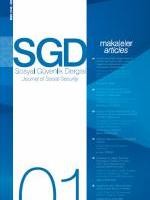Presentizm Olgusu
Çalışanın rahatsızlanmasına rağmen işine devam etmesi olgusu Presentizm olarak tanımlanır. Bu olgunun yaşanmasına yol açan çalışana, işyeri ortamına ve çalışma sistemine ilişkin pek çok etken vardır. Presentizmin sonuçları sadece gizli bir verimlilik kaybı değil aynı zamanda çalışanlar için güvenlik ve sağlık sorunlarıdır. Bu olgu ekonomi, sağlık, hukuk gibi pek çok bilim dalının el ele vererek çözebileceği bir durumdur. Özellikle iş sağlığı ve güvenliği uygulamalarında göz önüne alınması gerekir
Anahtar Kelimeler:
Presentizm, çalışma yaşamı, verimlilik, iş sağlığı ve güvenliği
Presentizm Olgusu
The case in which an employee continues his/her work in spite of an illness is defined as presenteeism. This case is caused by many reasons which are related to the employee, work environment and working system. The results of presenteeism include not only a subtle loss of productivity but also safety and health problems for the employees. This case can be solved by the help of economy, medical science and jurisprudence. Especially applications of work health and safety should be considered
Keywords:
Presenteeism, working life, productivity, occupationalhealthandsafety,
___
- American Diabetes Association (2003), “Economic Costs of Diabetes in the U.S. in 2002”, Diabetes Care, 26, 917-932.
- Aronsson, Gunnar, Klas Gustafsson, Margareta Dallner (2000), “Sick But Yet at Work. An Empirical Study of Sickness
- Presenteeism”, Journal of Epidemiology and Community Health, 54: 7, 502-509. Aronsson, Gunnar, Klas Gustafsson (2005), “Sickness Presenteeism: Prevalence, Attendance-Pressure
- Factors, and an Outline of a Model For Research”, Journal of Occupational and Environmental Medicine, 47, 958-966. Burton, Wayne N., Glenn Pransky, Daniel. J Conti, Chin-Yu Chen, Dee W. Edington (2001), “The Effects of Chronic Medical Conditions on Work Loss and Work Cutback”, Journal of Occupational and Environmental Medicine, 43: 3, 2182
- Burton, Wayne N., Glenn Pransky, Daniel J. Conti, Chin-Yu Chen, Dee W. Edington (2004), “The Association of Medical Conditions and Presenteeism”, Journal of Occupational and Environmental Medicine, 46: 6, 38-45.
- Burton, Wayne N., Daniel J. Conti, ChinYu Chen, Alyssa B. Schultz, Dee W Edington (1999), “The Role of Health Risk Factors and Disease On Worker Productivity”, Journal of Occupational & Environmental Medicine, 41: 10, 8638
- Cullen, John, Andrew McLaughlin (2004), “What Drives The Persistence of Presenteeism as Managerial Value In Hotels?: Observations Noted During an Irish Work-Life Balance Research Project”, Hospitality Management, 25: 510-5
- Çiftçi, Birgül (2010), “İşte Var Ol(Ama)Ma Sorunu ve İşletmelerin Uygulayabileceği Çözüm Önerileri”, Çalışma ve Toplum, 1,153-173.
- Goetzel, Ron Z., Stacey R. Long, Ronald J. Ozminkowski, Kevin Hawkins, Shaohung Wang, P. Wendy Lynch (2004), “Health, Absence, Disability and Presenteeism: Cost Estimates of Certain Physical and Mental Health Conditions Affecting U.S. Employers”, Journal of Occupational and Environmental Medicine, 46, 398-412.
- MacGregor, James N., J. Barton Cunningham, Natasha Caverley (2008), “Factors In Absenteeism and Presenteeism: Life Events and Health
- Events”, Management Research News, 31: 8, 607-615. McKevitt, Christopher, Morgan Myfanwy, Ruth Dundas, W.W. Holland (1997), “Sickness Absence and ‘Working
- Through’ Illness: A Comparison of Two Professional Groups”, Journal of Public Health, 19: 3, 295-300. Medibank, Sick at Work, 2011:2-11, www. medibank.com.au/Client/Documents/Pdfs/ sick_at_work.pdf, (29.03.2013).
- Middaugh, Donna J. (2006), Presenteeism: Sick and Tired at Work, MEDSURG Nursing, 15: 2, 103-105.
- Munir, Fehmidah, David Jones, Stavroula Leka, Amanda Griffiths (2005), “Work
- Limitations and Employer Adjustments for Employees with Chronic Illness”, International Journal of Rehabilitation Research, 28: 2, 111-117. Ricci, Judith, Walter F. Stewart, Elsbeth Chee, Carol Leotta, Kathleen Foley, Marc C. Hochberg (2005), “Pain Exacerbation as a Major Source of Lost Productive
- Time in US Workers with Arthritis”, Arthritis and Rheumatism, 53, 673-681. Schwartz, Brian S., Walter F. Stewart, Richard B. Lipton (1997), “Lost Workdays and Decreased Work Effectiveness
- Associated With Headache in The Workplace”, Journal of Occupational and Environmental Medicine, 39, 320-327.
- ISSN: 2146-4839
- Yayın Aralığı: Yılda 2 Sayı
- Yayıncı: T. C. Sosyal Güvenlik Kurumu
Sayıdaki Diğer Makaleler
Toplum Yararına Çalışma Programı: İşsizlikle Mücadelede Yeni Bir Yöntem mi?
İş Güvenliği Kültürünün Çalışanların Güvenli Davranışları Üzerine Etkisi
İşletmelerde Güvenlik Kültürünün Oluşumunda Yönetimin Rolü ve Önemi
Öğr. Gör. Gizem AKALP, Öğr. Gör. Dr. Nurettin YAMANKARADENİZ
